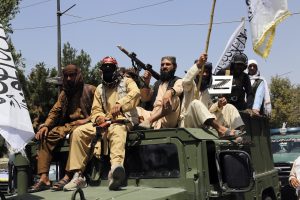In the wake of the September 11 attacks, the United States and its allies ousted the Taliban from power in Afghanistan in retaliation for providing safe havens to al-Qaida. By the 20th anniversary of the attacks, however, the Taliban had returned to Kabul.
The story of how and why the U.S. fought a 20-year war in Afghanistan – and how it ultimately lost that war – is a complicated tale. Four U.S. presidents oversaw the war in Afghanistan. The mission evolved, as did the wider foreign policy strategies onto which it was mapped. By one measurement, the United States spent $2.3 trillion on the war from 2001 to 2021 – a mind-blowing sum in light of the devastating conclusion.
In his book, “How to Lose a War: The Story of America’s Intervention in Afghanistan,” Amin Saikal lays out the convoluted path from a retaliatory intervention to defeat. In the following interview, Saikal, emeritus professor and founding director of the Centre for Arab and Islamic Studies at the Australian National University, helps explain the war’s evolution, the dysfunction of successive Afghan (and American) governments, and the fatal mistakes that doomed the effort to re-make Afghanistan into a democracy.
The Bush administration envisioned a “light footprint” as sufficient to achieve its aims in Afghanistan. It also sought to set the war within its wider foreign policy aims of “democracy promotion” and the “war on terror.” How did this constellation of circumstances and strategies hamper its ability to actually achieve its stated aims in Afghanistan?
Initially, the U.S. limited force deployment, spearheaded by the CIA and air power, rapidly prevailed against al-Qaida as the perpetrator of 9/11 and the extremist Taliban regime as the protector of al-Qaida under Osama bin Laden. But it resulted only in the dispersion of al-Qaida and the Taliban leaders and their operatives rather than in their total defeat.
Washington’s plan was not to “get bogged down” in Afghanistan. It was to help transform the country into a stable, secure, and democratic state within a relatively short period, and at minimum cost, in close relationship with the U.S. to ensure the country would never again become a hub for international terrorism. However, the failure to capture bin Laden as the main target of the intervention sooner rather than later led to a “hunt” for him that lasted 11 years, obliging America to deepen and widen its involvement in support of the difficult task of “nation-building” in Afghanistan.
Meanwhile, America’s Afghanistan campaign was conflated with two wider foreign policy objectives: democracy promotion and the war on terrorism. The first objective motivated the Bush administration to influence the shaping of the strong presidential system of governance with which Afghanistan was endowed and which was more akin to the American model than in accord with the mitigating prevailing and historical conditions in Afghanistan. The system proved unworkable in a highly socially divided and traditional country. It produced dysfunctional and kleptocratic governments under leaders who personalized politics and could not be effective and reliable partners of the U.S. on the ground.
The second objective spread out American power with the prime aim of toppling the defiant Saddam Hussein’s autocratic rule in Iraq, which Washington falsely linked to al-Qaida and accused of possessing weapons of mass destruction. The 2003 U.S. invasion of Iraq diverted many American military and intelligence resources from Afghanistan to Iraq in order to quell a raging insurgency there.
The Iraq war was prioritized over Afghanistan at a time when the Taliban, in alliance with al-Qaida, backed by Pakistan, rapidly regrouped and made a comeback with a vengeance before the U.S. and its Afghan and NATO allies could consolidate the situation in Afghanistan. U.S. forces remained thin on the ground and in need of more troops and military equipment, which only worsened as the Taliban-led insurgency expanded. By 2006, despite an increase in military assets, American forces and their allies were struggling to gain the upper hand over the Taliban and their supporters – a trend which continued, with the U.S. incapable of fighting two wars at the same time in contrast to the Pentagon’s doctrine.

































